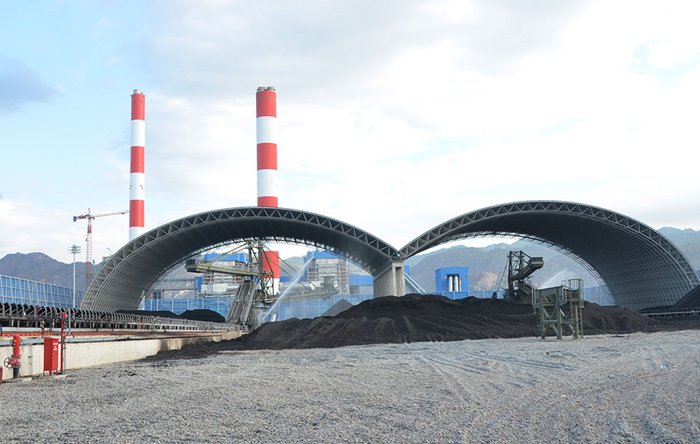Reporter: According to Deputy Minister, what should Viet Nam do to solve the "problem" of energy development and environmental protection?
Deputy Minister Dang Hoang An: To solve the problem of energy security, in association with environmental protection, Viet Nam should work out a reasonable energy structure. Viet Nam has been an energy exporter, but it will have to import energy in the future.
Ministry of Industry and Trade - Energy management agency, is looking for an optimal energy configuration, which ensures the use of electric power from various types (hydropower, coal, gas, and renewable energy, etc). Working out the optimal energy structure for a country is a very complicated issue. If all sources of environmental hazards are immediately removed, it will then affect national energy security. We set out the criteria for producing sufficient power and protecting the environment.
Reporter: So in the energy structure, how will Vietnam develop coal-fired and renewable energy, sir?
Deputy Minister Dang Hoang An: Coal-fired thermal-power or any sources should be calculated on the basis of national reserves. Coal thermal power with advanced technology, reasonable investment can completely limit environmental pollution. If people extremely think about coal-fired thermal-power, the country can suffer from energy insecurity.
Currently, the rate of renewable energy use in Viet Nam (including hydropower) on the total power source is far surpassing that of ASEAN countries. Thus, it can be said that we have gone ahead on the use of renewable energy.
The consistent policy of the Government is to encourage the development of renewable energy, but there is no energy structure depending heavily on renewable energy. Because this is a source of weather-dependent energy such as wind, solar radiation and these factors are often unpredictable and unstable.

Viet Nam needs to develop coal thermal power in the future to ensure energy security - Photo Minh Ngoc
Reporter: The investment for power sector from now to 2030 is USD 148 billion. How to mobilize this large amount of capital?
Deputy Minister Dang Hoang An: According to the objectives set out in the adjusted Power Plan VII, in the period of 2016-2020, with consideration until 2030, Viet Nam’s goal is to increase the total capacity of power plants to 130,000MW. Currently, the total capacity of power plants is 46,000MW, thus capital amount shall be needed to put 84,000MW more into operation. Guaranteed capital for the power sector is USD 148 billion.
There are many solutions, but the first task is to diversify investment sources. The Government understands that private investment, both domestically and internationally, is so important in power development. Recently, the Government has issued many proper policies to increasingly attract intensive and extensive participation by private investors in order to ease the burden of State capital in the power sector. Previously, investment capital was mainly based on state-owned enterprises such as Viet Nam Electricity Group, Viet Nam Oil and Gas Group, Viet Nam Coal-Mineral Industry Group.
Reporter: Is the increase in electricity price a solution to mobilize capital for the power sector, Mr. Deputy Minister?
Deputy Minister Dang Hoang An: Concerning the electricity prices, the Government's consistent point of view is to orientate the electricity prices in line with the market. Gradually, the power industry itself will perform right and full accounting and gain reasonable profit to expedite re-investment and development. On that basis, the power sector must control costs strictly, so that all costs shall be optimally determined. Thus, EVN is required to conduct strict administration to cure the "disease" of inefficient use of capital and to save up every capital amount for the Power sector.
Reporter: One of the important solutions to ensure energy security is to control the demand source, so what is the efficient solution for this?
Deputy Minister Dang Hoang An: Yes, in order to have sufficient energy for socio-economic development, on the one hand, there is a need to increase supply sources, on the other hand, to control the demand properly.
In order to promote economical and efficient use of energy, in the upcoming policy recommendations, it is proposed to shift from incentive to compulsory use of energy in saving manner and under sanction. Reducing the intensity of energy use requires strong enough sanctions as well as joint hands by society.
The potential of energy saving, especially electric power, remains very much. The elasticity ratio (the rate of electricity growth rate in comparison with the GDP growth rate) of the power was 1.8-2 but now has fallen to 1.5-1.6. The Government expects this figure to fall to 1.0 for ensuring competitiveness of the whole economy.
Accompanying these sanctions, the energy-intensive industries will be converted to less energy-intensive industries in the coming time. The production equipment must also be standardized in the spirit of lower energy consumption. For example, in the past we used incandescent bulbs, with a capacity of 40W or more, but now use LED lights. Although the initial investment cost is higher, power consumption is only 3-5W, saving a lot of energy.
evn.com.vn
Share